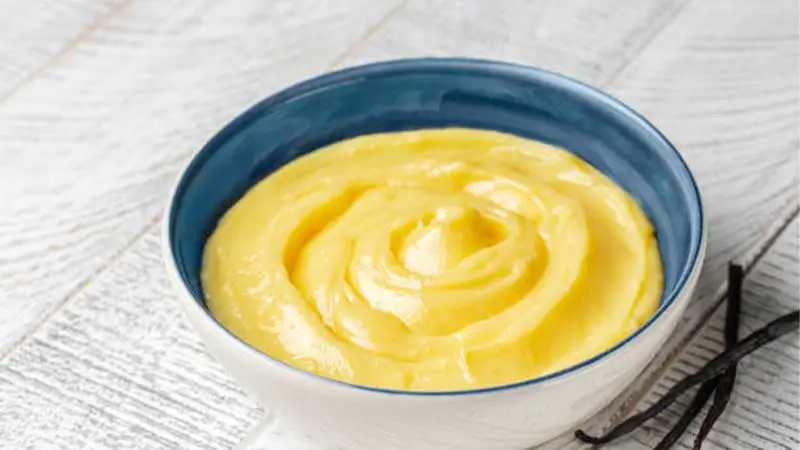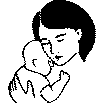Vanilla Custard Baby Food is a delightful and nutritious treat for your little one. It is packed with essential nutrients, vitamins, and minerals for your baby’s growth and development.
In this blog post, we will learn step-by-step how to make vanilla custard baby food at home and discuss why you should include it in your baby’s diet.

How to Make Vanilla Custard Baby Food:
Making Vanilla Custard Baby Food is easy and can be done in just a few simple steps.
Ingredients:
- 2 cups of whole milk
- 2 egg yolks
- 1/4 cup of sugar
- 1 teaspoon of vanilla extract
Instructions:
- Combine the whole milk, egg yolks, and sugar in a saucepan.
- Cook the mixture over medium heat, constantly stirring, until it thickens and coats the back of a spoon.
- Remove the saucepan from the heat and stir in the vanilla extract.
- Let the custard cool for a few minutes before transferring it to a blender or food processor.
- Puree the custard until it is smooth and creamy.
- Serve the custard immediately or store it in an airtight container in the refrigerator for up to three days.
Ideas for variations:
- FRUIT PUREE: Mix pureed fruit such as banana, peach, or mango for added flavor and nutrition.
- CINNAMON: Add a pinch of cinnamon to the custard mixture before cooking for a warm and comforting flavor.
- NUT BUTTER: Stir a small amount of nut butter, such as almond or peanut butter, for added protein and healthy fats.
- CHIA SEEDS: Add chia seeds for added texture and nutrition. The chia seeds will also help thicken the custard even more.
- YOGURT: Substitute some of the milk for plain yogurt to add a tangy flavor and even more nutrition to the custard.
Tips for Serving Vanilla Custard Baby Food:
- Start by serving small amounts of custard to your baby to ensure they have no allergies or adverse reactions.
- Mix the custard with mashed fruits or vegetables to add variety to your baby’s diet.
- Serve the custard in a small bowl or cup, using a soft-tipped spoon to feed your baby.
- Avoid adding sugar or sweeteners to the custard, as it is already naturally sweet.
Benefits of Vanilla Custard Baby Food:
1. Provides Essential Nutrients:
Vanilla Custard Baby Food is a rich source of essential nutrients such as proteins, vitamins, and minerals. Proteins are vital for your baby’s growth and development, while vitamins and minerals help to boost your baby’s immune system and overall health.
2. Easy to Digest:
Vanilla Custard Baby Food is easy to digest and gentle on your baby’s digestive system. It is perfect for babies just starting to eat solid foods and who may be experiencing digestive issues.
3. Great Taste:
Vanilla Custard Baby Food has a great taste that your baby will love. The smooth and creamy texture of the custard is perfect for babies transitioning from milk to solid foods.
4. Versatile:
Vanilla Custard Baby Food is versatile and can be combined with other fruits and vegetables to create various flavors. Mix it with mashed bananas, pureed sweet potatoes, or applesauce for a delicious and nutritious meal.
Nutritional Benefits:
Vanilla Custard Baby Food is delicious and a great source of essential nutrients for your baby’s growth and development. The whole milk used in this recipe provides a good source of protein and calcium necessary for healthy bone growth.
Egg yolks contain iron, essential for brain development, and vitamin A, which supports healthy vision. Additionally, vanilla extract is rich in antioxidants, which help to boost your baby’s immune system and protect against free radical damage.
Texture and Consistency:
The texture and consistency of Vanilla Custard Baby Food make it an ideal food for babies who are just starting to eat solid foods.
The smooth and creamy texture is gentle on your baby’s sensitive palate and easy to swallow. It is also a great food to help your baby transition from milk to solid foods.
Homemade vs. Store-Bought Vanilla Custard Baby Food
The Basics – Which is Better?
Parents often debate whether to make vanilla custard baby food at home or buy it from the store. Each has its own set of pros and cons.
| Criteria | Homemade | Store-Bought |
| Control over ingredients | Limited to available flavors and brands. | Ingredients vary widely; some include additives. Always check labels. |
| Convenience | It requires time and effort to prepare. | Prepackaged; ready to serve. |
| Cost | It is often more cost-effective to use everyday pantry items. | It can be pricier due to branding or premium claims. |
| Freshness | Made fresh at home, ensuring optimal nutrition. | Shelf-stable; may have more prolonged expiration due to preservatives. |
| Variety & Customization | Easily adjusted to suit your baby’s taste or dietary needs. | Limited to available flavours and brands. |
Ultimately, the best choice depends on your lifestyle, time, and comfort level with cooking.
How to Serve and Support Children Effectively?
Vanilla Custard Baby Food can be served as a standalone meal or combined with other fruits and vegetables to create a variety of flavors.
For example, mix it with mashed bananas, pureed sweet potatoes, or applesauce for a delicious and nutritious meal. You can also top it with fresh berries or add some cinnamon.
Allergies and Safety Precautions:
Before introducing Vanilla Custard Baby Food to your baby’s diet, it is important to check for any food allergies. Always start with a small amount and monitor your baby for any signs of an allergic reaction, such as swelling, hives, or difficulty breathing.
Additionally, follow safe food handling practices, such as washing your hands and utensils thoroughly before preparing the food and storing it in airtight containers in the refrigerator.
Conclusion:
Introducing your baby to new foods can be daunting, but with vanilla custard baby food, it doesn’t have to be. The creamy texture, sweet taste, and nutritional benefits make it ideal for babies who are just starting to eat solid foods.
With these simple instructions and tips, you can easily create and serve vanilla custard baby food to your little one, helping them develop a taste for new and exciting foods.
FAQ:
Is vanilla custard good for babies?
Vanilla custard can be a good food for babies when introduced at the appropriate age and in moderation. Custard is made from a combination of milk, sugar, and eggs, which can provide important nutrients for growing babies, such as protein, calcium, and vitamin D. However, it is important to note that vanilla custard can also be high in sugar and fat, which can be unhealthy in excess. Therefore, it should be consumed in moderation and as a balanced diet. It is also important to introduce new foods one at a time to monitor for any signs of allergic reactions or digestive issues. As always, it is recommended to consult with your pediatrician before introducing new foods to your baby’s diet.
At what age can babies eat custard?
Babies can typically start eating solid foods, including custard, between four and six months of age, depending on their development and readiness. However, it is important to introduce new foods one at a time to monitor for any signs of allergic reactions or digestive issues. It is recommended to start with small amounts of custard and gradually increase the quantity as the baby tolerates it well. Additionally, it is important to choose a custard that is appropriate for babies and free from additives, preservatives, or added sugars. Always consult your pediatrician before introducing new foods to your baby’s diet.
Which custard is best for babies?
When choosing a custard for babies, it is important to look for one that is labeled explicitly as appropriate for babies and free from additives, preservatives, or added sugars. Homemade custard can also be a good option, allowing you to control the ingredients. Choosing a custard made with whole milk is also recommended, as it provides important nutrients for growing babies, such as protein, calcium, and vitamin D. Ultimately, the best custard for your baby will depend on their needs and preferences. As always, it is recommended to consult with your pediatrician before introducing new foods to your baby’s diet.
When can I introduce my baby to vanilla custard baby food?
Babies can typically start eating solid foods, including custard, between four and six months of age, depending on their development and readiness. Always consult your pediatrician before introducing new foods to your baby’s diet.
Can I make my own vanilla custard baby food?
Yes! Homemade vanilla custard baby food can be a great option for parents who want to control the ingredients in their baby’s food. Many simple recipes are available online, or you can consult a pediatric nutritionist for guidance.
Can vanilla custard baby food cause allergies?
Like any new food, there is a risk of allergies when introducing vanilla custard baby food to your baby. Symptoms of an allergic reaction can include hives, swelling, difficulty breathing, or vomiting. Always introduce new foods one at a time, and watch for any signs of an allergic reaction.
How should I store vanilla custard baby food?
Store-bought vanilla custard baby food should be kept in the refrigerator until ready to use. The homemade custard should also be stored in the fridge and consumed within a few days of preparation. Never leave custard at room temperature for extended periods.
How can I serve vanilla custard baby food to my baby?
Vanilla custard baby food can be served at room temperature or slightly warmed for added comfort. It can be spoon-fed to your baby or added to other purees to create new flavors and textures. Always be sure to test the temperature of the custard before feeding it to your baby. Vanilla custard baby food can be a tasty and nutritious addition to your baby’s diet. Still, it should always be introduced in moderation and with careful attention to your baby’s individual needs and preferences. As always, consult your pediatrician before introducing new foods to your baby’s diet.

Pingback: Can A 1 Year Old Eat Junk Food? Junk Food and the Developing Brain
Pingback: Ready, Set, Eat! When Can Babies Start Eating Baby Food?
Pingback: When Can My Baby Start Eating Solid Foods? A Parent's Guide to Introducing Solid